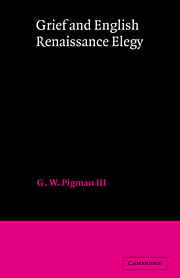Book contents
- Frontmatter
- Contents
- Acknowledgments
- Introduction
- Chapter 1 The Angry Consoler
- Chapter 2 The Emergence of Compassionate Moderation
- Chapter 3 Praise and Mourning
- Chapter 4 The Shift from Anxious Elegy
- Chapter 5 Surrey and Spenser
- Chapter 6 Jonson and King
- Chapter 7 Milton
- Conclusion
- Notes
- Bibliography
- Index
Chapter 4 - The Shift from Anxious Elegy
Published online by Cambridge University Press: 28 August 2009
- Frontmatter
- Contents
- Acknowledgments
- Introduction
- Chapter 1 The Angry Consoler
- Chapter 2 The Emergence of Compassionate Moderation
- Chapter 3 Praise and Mourning
- Chapter 4 The Shift from Anxious Elegy
- Chapter 5 Surrey and Spenser
- Chapter 6 Jonson and King
- Chapter 7 Milton
- Conclusion
- Notes
- Bibliography
- Index
Summary
Grimald is not the only sixteenth-century poet who is more concerned with what he is supposed to feel than with what he is actually feeling. His anxieties about the legitimacy of grief are characteristic of elegy throughout the greater part of the century. Setting aside elegies which are primarily panegyric or which indulge in hyperbolic grief, one finds much more defensiveness about mourning than actual expression of sorrow. Anxiety about violating the various cultural norms is often the dominant feeling in the poem. None of the sixteenth-century poets, consolers, or theologians can express grief as simply and unself-consciously as Henry King does in ‘An Exequy’, the moving poem on the death of his wife in 1624.
Accept, thou Shrine of my dead Saint!
Instead of Dirges this Complaint;
And, for sweet flowres to crowne thy Hearse,
Receive a strew of weeping verse
From thy griev'd Friend; whome Thou might'st see
Quite melted into Teares for Thee.
King is not inhibited about his grief and does not exaggerate it; nor does his poem show a trace of anxiety about moderation or the legitimacy of mourning. He celebrates a private funeral rite and focuses on his memories of his wife and his sense of loss. He does not take refuge in hyperbolic grief, nor does he merely hint at the great depths of his sorrow by means of an inexpressibility topos.
- Type
- Chapter
- Information
- Grief and English Renaissance Elegy , pp. 52 - 67Publisher: Cambridge University PressPrint publication year: 1985



